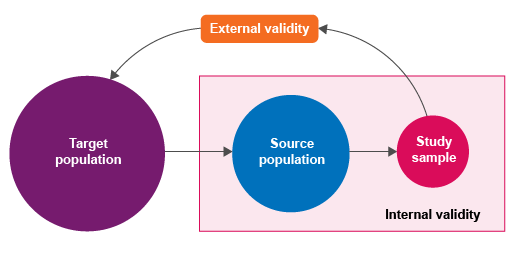5.2.2 Validity
target (reference) population – the population to which the results will be applied or extrapolatedsource (study) population – actual population from which eligible study subjects are drawnstudy sample – the units selected from the source populationsampling unit – the epidemiological unit in which we are measuring exposure and outcome (e.g. individual animals or herds). The term ‘sampling unit’ has the same meaning as data unit in this context.
There is more information about these concepts in the modules on Sampling.
As shown in Figure 5, validity can be divided into:
internal validity – the degree to which study results are representative of true study population values: the ‘truth’ within the studyexternal validity – the degree to which study results can be extrapolated to the target population: the ‘truth’ outside the study.
Activity 16: Validity in your workplace
Think about your own workplace. What populations are sampled? For example, does your organisation mainly treat or conduct testing on healthy individuals, or sick individuals (people or animals)? What are the implications for internal and external validity? What can be done to improve the validity of your studies?
Discussion
Here are some suggestions for improving validity:
- Make sure you are sampling representative data points. For example, don’t just sample broiler chickens reared in a large commercial farm if you want to learn about AMR in chickens in a country where most chickens are raised by smallholders.
- Evaluate the validity of a study when interpreting its results. Don’t make conclusions at a population level based on a study with a biased, non-representative sample.
- Increase access to training like this module to educate your colleagues and peers on the importance of validity.
5.2.1 Accuracy and precision




